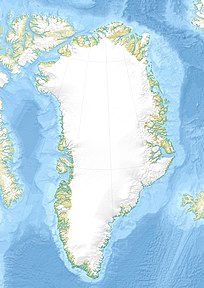Akunnaat
| Akunnaat | ||
|---|---|---|
| Akúnât | ||
| Lichtenfels (around 1900) | ||
| Commune | Kommuneqarfik Sermersooq | |
| District | Nuuk | |
| Geographical location | 63 ° 3 '39 " N , 50 ° 44' 30" W | |
|
|
||
| Residents | 0 (1951) |
|
| founding | 1758 | |
| Time zone | UTC-3 | |
Akunnaat [ aˈkunːaːtˢʰ ] (according to the old spelling Akúnât ; German Lichtenfels ) is a desolate Greenlandic settlement in the Nuuk district in the Kommuneqarfik Sermersooq .
location
Akunnaat is located on the island of Qeqertarsuatsiaq . Qeqertarsuatsiaat is located five kilometers northeast on the same island .
history

Akunnaat was founded in 1758 by the Moravian Brethren as a mission station in Lichtenfels, shortly after the Danes had founded the lodge in Qeqertarsuatsiaat. The mission was slow at first, but after an Angakkoq was converted in 1768 , more and more Greenlanders were quickly baptized. From 1766 to 1786 Hans Henrik Raun worked as an assistant in Qeqertarsuatsiaat and he supported the Moravian Mission. The best-known missionary in Lichtenfels was the Upper Silesian Johann Beck (1706–1777).
In 1877, according to Hinrich Johannes Rink , Lichtenfels had 150 inhabitants, while only 90 people lived in the lodge. Some of the residents left the place and established new places to live in the area. In 1900 the Moravians left Greenland and Lichtenfels was handed over to the Danish Mission. From 1911 Akunnaat belonged to the municipality of Fiskenæsset.
In 1918 45 people lived in the village, living in six very poorly built houses. As usual for the Moravian community, the residents were of no European descent. At that time the old missionary apartment was still standing in Akunnaat, which also functioned as a church and school building. At 9.5 × 23 meters, the building was huge by the standards of the time and there were three living rooms, an altar, a kneeling bench and an organ. The building has been empty since 1900. Among the residents were nine hunters who made their living mainly by hunting seals. There was also an untrained catechist living in Akunnaat.
In the first half of the 20th century, a maximum of 73 people lived in Akunnaat before the last 30 inhabitants left the place in 1950.
Sons and daughters
- Theofilus Johnsen (1894–?), National Councilor
literature
- David Cranz : History of Greenland containing the description of the country and the inhabitants etc. in particular the history of the mission of the Evangelical Brothers there to New Herrnhut and Lichtenfels . Barby and Leipzig, Ebers and Weidmann Erben, 1765 (digital copies of the 2nd edition 1770 as PDF: Vol. 1 (PDF; 42.2 MB), Vol. 2 (PDF; 25.3 MB))
Individual evidence
- ↑ Map with all official place names confirmed by Oqaasileriffik , provided by Asiaq
- ↑ Louis Bobe : Beskrivelse af Distrikterne i Sydgrønland: Godthaab district. History. Fiskenæsset . In: Georg Carl Amdrup , Louis Bobé , Adolf Severin Jensen , Hans Peder Steensby (eds.): Grønland i tohundredeaaret for Hans Egedes landing (= Meddelelser om Grønland . Volume 60-61 ). tape 2 . C. A. Reitzel Boghandel, Copenhagen 1921, p. 291 ff . ( Digitized in the Internet Archive ).
- ↑ Ole Bendixen : Beskrivelse af Distrikterne i Sydgrønland: Godthaab district. Bopladser i Godthaab district. Bopladsen Lichtenfels . In: Georg Carl Amdrup , Louis Bobé , Adolf Severin Jensen , Hans Peder Steensby (eds.): Grønland i tohundredeaaret for Hans Egedes landing (= Meddelelser om Grønland . Volume 60-61 ). tape 2 . C. A. Reitzel Boghandel, Copenhagen 1921, p. 264 ff . ( Digitized in the Internet Archive ).
- ↑ Jens Christian Madsen: Udsteder og bopladser i Grønland 1901-2000 . Atuagkat, 2009, ISBN 978-87-90133-76-4 , pp. 83 .


